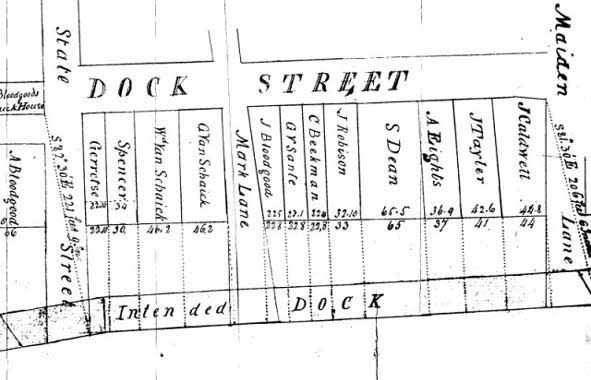
Howell’s Bi-Centennial History of Albany tells us that in the mid-1700s, there were a number of sloops and schooners trading between Albany, New York and Boston, and sometimes beyond, but that none had ventured to foreign ports. In 1770, Captain Abraham Bloodgood made the first voyage from Albany to the West Indies carrying a cargo of local products mixed with the shame of slavery: “an assorted cargo, consisting of flour, herrings, horses, one negro man, and a great variety of the products of this county. In exchange for which were brought back eighty-one pounds of cotton – a much rarer commodity than now – some cash, and much rum.” Howell also says that Lansingburgh (then much larger than Troy) and Hudson were in regular communication with the West Indies, while the Albany Gazette in 1790 “marveled that the citizens of Albany should remain inactive spectators while their neighbors on the north and south were ‘participating in all the blessings of this valuable trade.’”
Some years later, Stewart Dean, already a patriot pirate, laid claim to being Albany’s greatest explorer with an 18-month trip to China, in 1785. (Stefan Bielinski at the NYS Museum has put together the definitive webpage on Dean.) Born and apprenticed in Maryland, Dean was sailing out of Albany by 1771, and married into the Bradt family in 1773. He bought a lot on the waterfront and built a home on Dock Street; it was renamed Dean Street in his honor but is now a forgotten stub paralleling Broadway between State and Exchange. He served as a privateer for the American cause in the Revolution; there was much booty.
After the Revolution and the death of his wife, Stewart Dean was inspired to sail to China aboard a ship built in Albany, the Experiment. Len Tantillo, who has painted his idea of the Experiment, says that it was a typical work boat, just under 60 feet long and registered at 85-1/2 tons. It first sailed in 1784 to Madeira.
In 1785, The Empress of China became the first American ship to trade with China, returning to New York on May 11 and clearing a substantial profit for its investors that drew the attention of others, who were finding ordinary trade conditions most unprofitable. Dean, who was partnered with Albany’s Teunis Van Vechten, was backed by a group of New York investors who agreed “to fit out the Sloop Experiment Stewart Dean Master for Canton in China…the expences of Vessel & Cargo not to exceed the sum of £10,000 N.Y. Currency.” With money raised, the ship was fitted out for a longer sea voyage, with a longer topmast and extended jib-boom, with rigging that “gave the Experiment a very comprehensive suit of sails for light weather.” The sloop also carried two ten-pound carriage guns, small arms, blunderbusses, pistols, gunpowder and ammunition.
The Experiment left from the East River on December 18, 1785, with Dean in command, John Whetten as first mate, Isaac Seaman as second mate, and a crew of five men and two boys, and a William Stewart who sailed as supercargo. They sailed around the Cape of Good Hope, across the Indian Ocean, and through the Java and China seas, arriving in Canton on June 13, 1786.
What do you sell to China, when only one ship has ever done trade there before? The Empress of China had taken 30 tons of Appalachian ginseng (30 TONS of ginseng), 50 tons of cordage, 30 tons of lead, and planking, cloth, wines and spirits. Of the $270,000 it sold for, $240,000 of that was the ginseng. Naturally the backers of the Experiment focused on ginseng, but couldn’t come up with anything like that quantity, and didn’t fetch that kind of money. The much smaller Experiment also carried alcohol, but didn’t clear much profit on that, either. Their furs and tobacco were sold at a loss. In all the goods cost the backers $4143, and sold for $7549. That would be great, except there were expenses of $4679, cutting into what Dean had available to buy other trade goods in China. They brought back substantial amounts of tea, 26 chests of china tea cups and saucers, 5 chests of breakfast china, and 80 bales of nankeens (yellowish-buff pants).
After this only modestly successful journey, the Experiment returned to running up and down the Hudson. Dean remarried in 1787 (to Margaret Whetten), and continued in the cargo and passenger businesses. He died in New York City on August 4, 1836, aged 89.
(The pages of the Peabody Essex Museum provided much of the detail on the journey of the Experiment.)

Leave a Reply